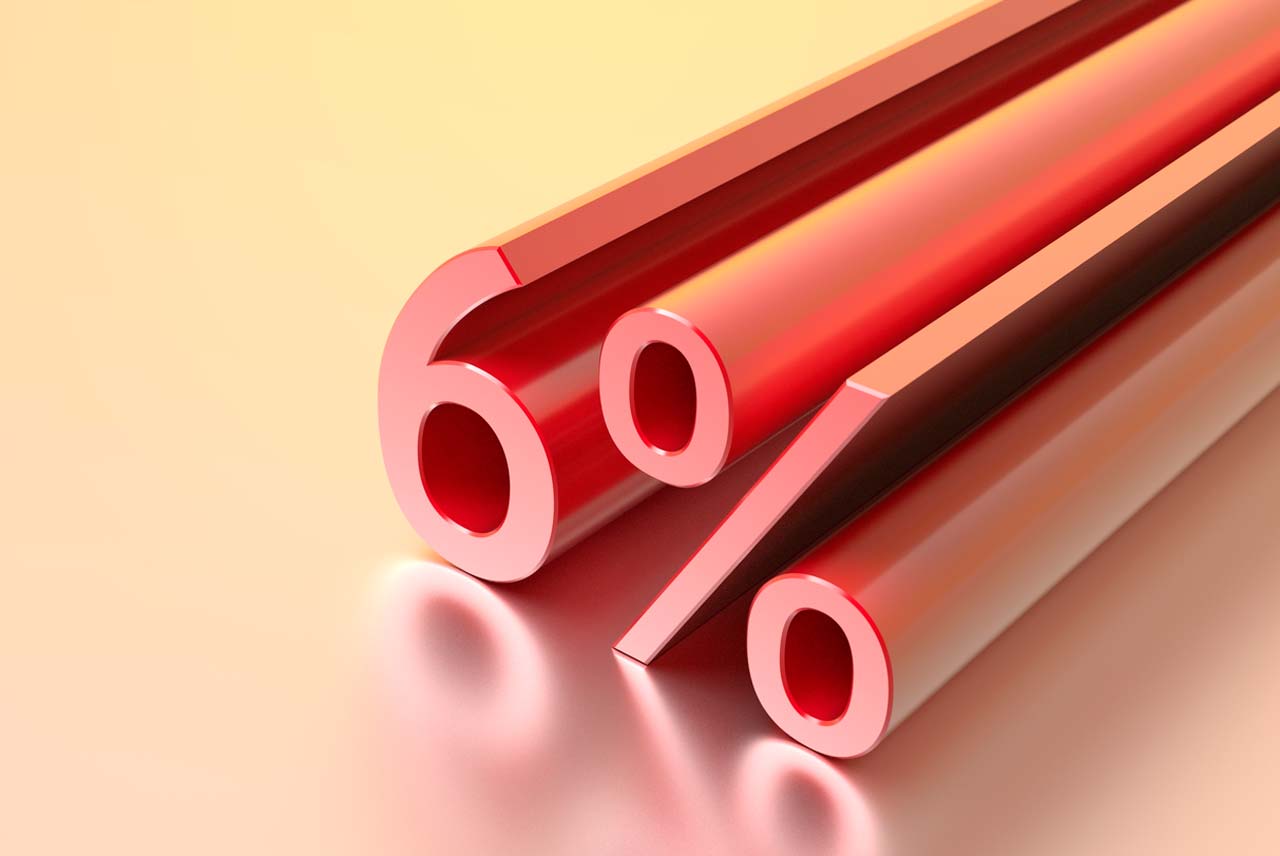4 Good Preferred Stocks Yielding 6% or More
All of our picks offer several years of protection against early redemptions. We also suggest a fine ETF.


An aura of income is all it takes to lure investors to dividend-paying stocks these days. But if payouts on common stocks don’t hold much appeal to you, consider a company’s preferred shares.
Even with their prices hitting 52-week highs, many high-quality preferreds still yield 5% or more. These stocks may not have much potential for gains after running up in price this year. But they should still generate more income than many other yield-oriented investments, including government bonds (1.5% for 10-year Treasuries), property-owning real estate investment trusts (an average of 3.6%) and utilities (3.4%).
Preferreds straddle the gap between stocks and bonds. Like stocks, they trade on exchanges. And like bonds, they make regular, though fixed, payments to investors. But bonds pay interest, while preferreds pay dividends, typically every three months. Many preferreds pay so-called qualified dividends; the top federal tax rate on those payouts is 15%, compared with a top rate of 43.4% on interest income.

Sign up for Kiplinger’s Free E-Newsletters
Profit and prosper with the best of expert advice on investing, taxes, retirement, personal finance and more - straight to your e-mail.
Profit and prosper with the best of expert advice - straight to your e-mail.
Companies typically issue preferreds at $25 per share. Prices may drift above or below that level, typically moving up as interest rates fall and moving down when rates rise. Critically, companies can “call,” or redeem, their preferreds at a specified date in the future or, in some cases, at any time. Buying a preferred close to $25 gives you some assurance that if a company does redeem the stock, you won’t lose much of your initial investment. But be careful not to buy a preferred well above $25 a few months before its initial call date; doing so could saddle you with losses, even after accounting for dividend income.
Companies may also have some leeway to suspend dividend payments. If a preferred is “cumulative,” the firm must eventually shell out any dividends it didn’t pay. But many preferreds are “non-cumulative:” If a company runs into financial trouble and suspends payments, it isn’t required to make good on the missed disbursements at a later date.
Preferreds have other risks, too. They aren’t as stable as high-quality corporate bonds, and that can sting in the event of a market panic. In 2008, for instance, iShares U.S. Preferred Stock (symbol PFF, $40.04, yield 5.4%), an exchange-traded fund, posted a total return of -24%, after accounting for dividend payments. (Prices and yields are as of August 22.)
Today’s high prices have pushed yields down, providing less of a safety net if the market takes a tumble. In such a pricey environment, it’s important to stick with high-quality preferreds, which are likely to hold up better than lower-quality preferreds during a selloff, says Michael Greco, a preferred-stock investor and chief investment officer of GCI Financial Group, a money-management firm in Mendham, N.J.
Because preferred dividends are fixed, the stocks would also slump if interest rates were to rise. A preferred trading at $27, for instance, could drop to $22 if the yield on the benchmark 10-year Treasury bond were to climb to 2.5%. Kiplinger’s doesn’t see a big rise in bond yields anytime soon. We expect the 10-year Treasury to finish 2016 at 1.4% and to climb to 1.8% by the end of 2017. Still, interest rates could spike if inflation becomes more of a concern, posing a threat to preferreds in the background.
For access to a diverse package of stocks, consider the iShares preferred ETF. It holds more than 280 preferreds issued mainly by banks, real estate firms and insurance companies. Most of these firms carry investment-grade ratings, although the ETF does own some with lower ratings. Its annual expense ratio is 0.47%.
For a bit more income, consider buying one or more of the four preferreds described below. Note that ticker symbols for these stocks aren’t consistent across brokerage firms and financial websites. If you can’t find a symbol, visit www.quantumonline.com, a free site where you can look up preferred share classes by entering the issuer’s name.
AmTrust Financial Services, 7.75% Dep Shares Non-Cumulative Preferred Series E (AFSI.E, $27.00, 7.2%)
AmTrust specializes in small-business insurance, selling coverage for workers’ compensation, extended warranties and other types of property and casualty insurance. Revenues should hit $4.7 billion this year, up from $4 billion in 2015, according to Wall Street estimates. Analysts see the firm booking profits of $470 million in 2016. The company earns a solid A rating, moreover, from A.M. Best, a firm that evaluates the financial health of insurance providers.
AmTrust’s preferred looks attractive for its above-average yield and secure payout, says Greco. The firm paid $11.6 million in preferred dividends in the second quarter of 2016, well below its profits of $135 million. Shares aren’t callable until March 2021, and the dividends qualify for the 15% tax treatment. However, they aren’t cumulative.
Citigroup, Inc., 8.125% Dep Shares Series AA Non-cumulative Preferred (C.P, $27.68, 7.3%)
After suffering a near-death experience during the Great Recession, Citigroup now appears to be on much sounder footing. The giant bank, which holds more than $2.1 trillion in assets, recently passed its annual “stress test,” administered by the Federal Reserve, winning permission to more than triple its common stock dividend and buy back up to $8.6 billion in shares over the next year. Analysts expect the firm to report $21 billion in profits in 2016 on revenues of $69.9 billion.
Citi’s improving finances bode well for its preferred stock. Although the shares trade well above par value, they still offer a generous yield. Citi can’t redeem the stock until February 2018, and dividends qualify for the 15% tax treatment. Payments aren’t cumulative.
JPMorgan Chase & Co., 6.70% Dep Shares Non-Cumulative Preferred, Series T (JPM.B, $28.02, yield 6.0%)
The largest bank in the U.S., with assets of more than $2.4 trillion, JPMorgan runs a massive and sprawling financial business. Its balance sheet and capital levels have improved sharply since the financial crisis, and it’s now soundly profitable. Analysts forecast $20.6 billion in earnings this year on revenues of $96.2 billion.
JPMorgan issues many classes of preferred stock. But the recently issued Series T looks like one of the most compelling now. Dividends qualify for the 15% tax rate, and the bank can’t redeem the stock until March 2019. The dividends aren’t cumulative.
KKR & Co. 6.50% Series B Non-Cumulative Preferred (KKR.B, $26.70, 6.1%)
KKR owns more than $30 billion in investments, ranging from private equity to ownership stakes in publicly traded firms, such as HCA Holdings (HCA), Walgreens Boots Alliance (WBA) and U.S. Foods Holdings (USFD). KKR also generates income from hedge funds and other investments. Bank of America Merrill Lynch rates KKR’s common stock a “buy,” seeing improvements in the business and a rising level of fee-based income as the firm diversifies its revenue streams.
KKR’s profits can still be erratic. But its preferred dividends look solid. Analysts expect KKR to earn $394 million this year, providing ample coverage for its payout of $15.8 million on preferred shares. The dividends aren’t cumulative, and they don’t qualify for the 15% tax rate. But KKR can’t redeem the shares until September 2021.
Get Kiplinger Today newsletter — free
Profit and prosper with the best of Kiplinger's advice on investing, taxes, retirement, personal finance and much more. Delivered daily. Enter your email in the box and click Sign Me Up.

-
 Married? Five Ways to Ensure Your Estate Plans Work in Tandem
Married? Five Ways to Ensure Your Estate Plans Work in TandemGetting on the same page now means fewer potential problems when it counts.
By Kiplinger Advisor Collective
-
 12 Investments No Retiree Should Make
12 Investments No Retiree Should MakeIn retirement, when it's wise to take fewer risks with your nest egg, some investments are just nuts.
By David Rodeck
-
 Why Is Warren Buffett Selling So Much Stock?
Why Is Warren Buffett Selling So Much Stock?Berkshire Hathaway is dumping equities, hoarding cash and making market participants nervous.
By Dan Burrows
-
 If You'd Put $1,000 Into Google Stock 20 Years Ago, Here's What You'd Have Today
If You'd Put $1,000 Into Google Stock 20 Years Ago, Here's What You'd Have TodayGoogle parent Alphabet has been a market-beating machine for ages.
By Dan Burrows
-
 Stock Market Today: Stocks Retreat Ahead of Nvidia Earnings
Stock Market Today: Stocks Retreat Ahead of Nvidia EarningsMarkets lost ground on light volume Wednesday as traders keyed on AI bellwether Nvidia earnings after the close.
By Dan Burrows
-
 Stock Market Today: Stocks Edge Higher With Nvidia Earnings in Focus
Stock Market Today: Stocks Edge Higher With Nvidia Earnings in FocusNvidia stock gained ground ahead of tomorrow's after-the-close earnings event, while Super Micro Computer got hit by a short seller report.
By Karee Venema
-
 Stock Market Today: Dow Hits New Record Closing High
Stock Market Today: Dow Hits New Record Closing HighThe Nasdaq Composite and S&P 500 finished in the red as semiconductor stocks struggled.
By Karee Venema
-
 Stock Market Today: Stocks Pop After Powell's Jackson Hole Speech
Stock Market Today: Stocks Pop After Powell's Jackson Hole SpeechFed Chair Powell's Jackson Hole speech struck a dovish tone which sent stocks soaring Friday.
By Karee Venema
-
 Stock Market Today: Stocks Drop Ahead of Powell's Jackson Hole Speech
Stock Market Today: Stocks Drop Ahead of Powell's Jackson Hole SpeechSentiment turned cautious ahead of Fed Chair Powell's highly anticipated speech Friday at the Jackson Hole Economic Symposium.
By Karee Venema
-
 Stock Market Today: Stocks Rise After Jobs Data Lifts Rate-Cut Odds
Stock Market Today: Stocks Rise After Jobs Data Lifts Rate-Cut OddsPreliminary data from the Bureau of Labor Statistics shows job growth was lower than previously estimated.
By Karee Venema